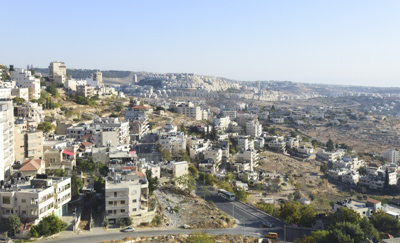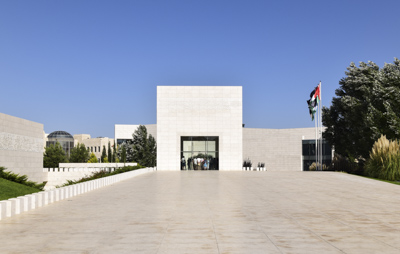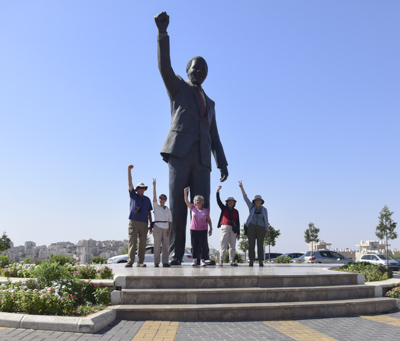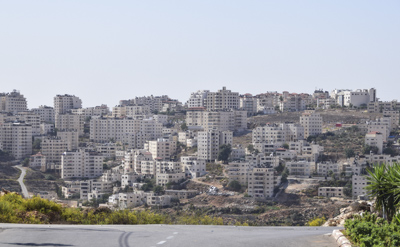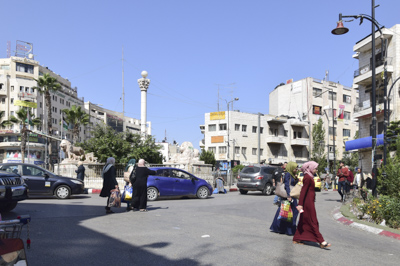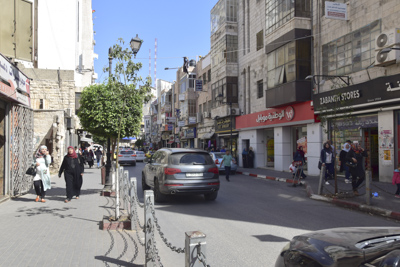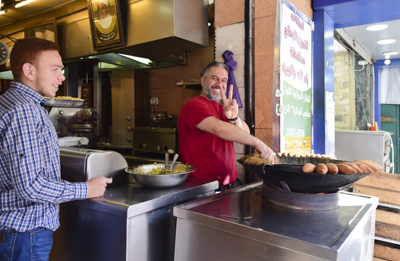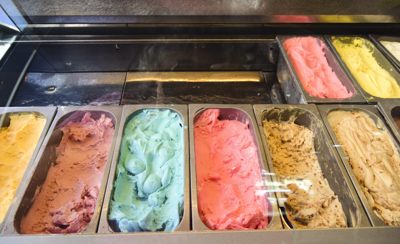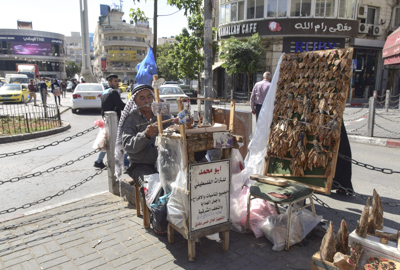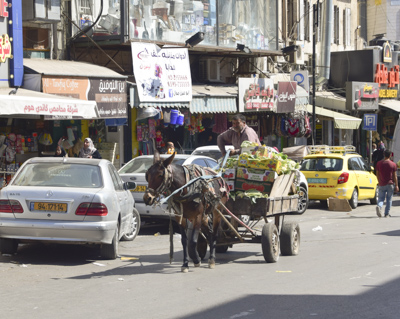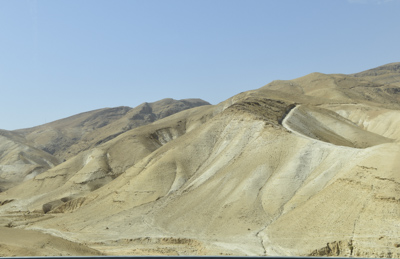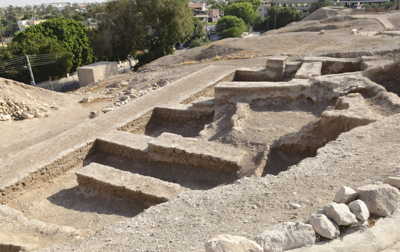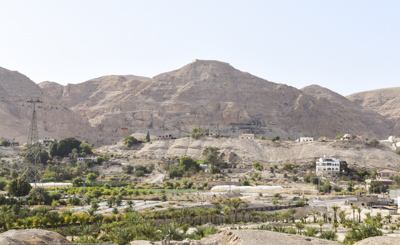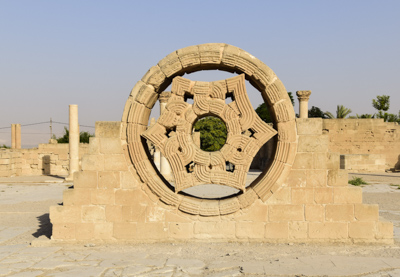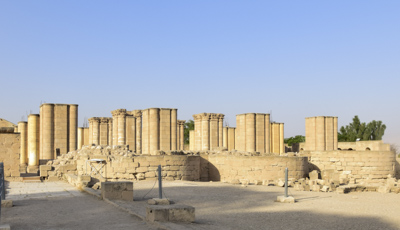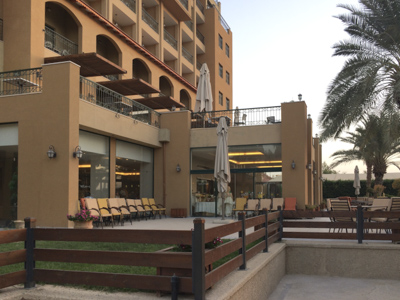Wednesday – October 18, 2017
There was another crowd of pilgrims in the breakfast room of the Manger Square Hotel this morning. Large groups of people from every corner of the world come to Bethlehem to visit the Church of the Nativity: Philippines, Australia, Germany, Italy, England, Africa, and, of course, the U.S. View of modern Bethlehem this morning from my window:
It was another bright sunny morning. We checked out of the hotel and drove north to the city of Ramallah. On the way, we stopped at Yasser Arafat’s mausoleum. He was the leader of the Palestine Liberation Organization for five decades, who died suddenly in 2004.
Yasser Arafat’s tomb is located in the Al Muqata’a, or Presidential Compound and is the headquarters of the current Palestinian Presidential Office and the Palestinian Authority. The compound, which was reduced to rubble in 2002, today includes a government building, a museum which honors Arafat, his mausoleum, and a mosque.
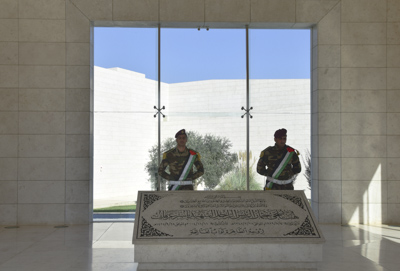
In 1994, Yasser Arafat received the Nobel Peace Prize together with Yitzak Rabin and Shimon Peres, the Israeli leaders, for their peaceful efforts in the Oslo Accords. The peaceful intent of the Accords divided both the Israelis and Palestinians within their own societies, and the leaders were criticized for their peace efforts by their own people. In Israel last week, we had visited the site where Yitzak Rabin was killed in Tel Aviv.
We stopped to see the 20 foot-tall statue of Nelson Mandela which was given to the city of Ramallah by the South African city of Johannesburg in 2016. Mandela was an ardent supporter of the Palestinian cause and a champion for Middle East peace.
One of the biggest surprises to me about the entire region, is how hilly it is! Ramallah spreads across several steep hills. As we drove to the city center through a neighborhood of affluent houses, I looked across a valley at the high-rises on the next hill.
Ramallah, which means “God’s hill,” is located just six miles north of Jerusalem and serves as the administrative capital of the Palestinian National Authority. It’s a modern city with an exciting youthful vibe. There are fashionable shops, lots of traffic, restaurants, bars, and movie theaters.
Ramallah was historically an Arab Christian town, which might account for its religiously relaxed atmosphere. Alcohol is served in restaurants and many women do not wear headscarves.
We sampled the kebbeh cooked fresh from the street-side vendor in the photo above. It’s made with cracked wheat, onions, finely ground beef, lamb or goat. Hisham bought us “Palestinian ice-cream” from the famous Rukab Ice-cream Shop which has been in business since 1941. It is gooey, sticky, and thicker than regular ice-cream, but tastes delicious. Also called booza or mastic, it’s made from resin from a local tree. It’s supposed to melt slower than regular ice-cream, which is a benefit in this hot climate.
More scenes walking around Ramallah: a street vendor carving wooden trinkets:
Pharmacist describing dosage in perfect English:
Just when I thought Ramallah was a 21st century modern city, a mule and cart drove by:
Lavash & bread maker:
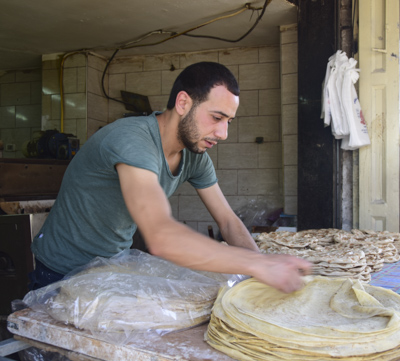
Farmer’s Market:
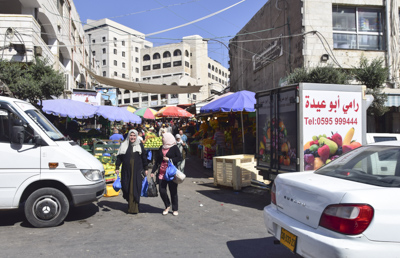
We left Ramallah and drove back into the desert northbound toward Jericho. It was easy to forget the surrounding terrain while walking around a bustling city.
Our first stop was a cafeteria-style lunch at the Jericho Temptation Restaurant. Afterwards, we went to the Jericho Oasis Archaeological Park. This is the site of the tel es-Sultan, a UNESCO-listed archaeological site.
Sultan’s Hill was inhabited from the 10th millennium BC and has been called “the oldest town in the world.” Excavations began in 1868 and continue today in cooperation with archaeologists from Rome, Italy.
A defensive wall – The Wall of Jericho – was also discovered which dates back to 8,000 BC. We looked across the plain to the Mount of Temptation:
Close by was Hisham’s Palace which belongs to a category of “desert castles” and is an important early Islamic archaeological site. The site was part of the Umayyad dynasty during the first half of the 8th century.
Hisham’s Palace consists of three main parts: a palace, ornate bath complex, and an agricultural enclosure or park. There was also an elaborate irrigation system which provided the complex with water from nearby springs.
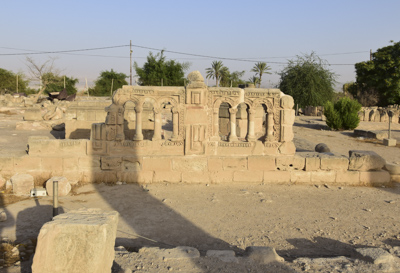
Carved stucco found at the site is of exceptional quality and decorative elements represent the finest of the Umayyad period of art. The most famous art at the site is the “tree of life” mosaic found in the bath complex.
Below is a model of what historians believe the palace looked like:
As the sun cast long shadows on Hisham’s Palace, we left the site and drove a short distance to the Jericho Resort Village Hotel. The dining room overlooks the outdoor patio and the pool.
The hotel was an oasis in the desert with a large hotel building and smaller family cottages built along the pool area. We each had individual two-room suites in the cottages. The architecture reminded me of the adobe desert communities we had been passing for the last few weeks. My cottage below:
It was a great way to end a busy day!
